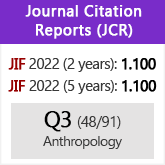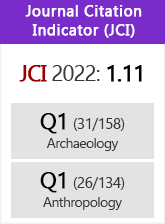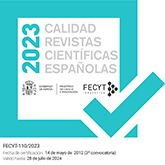Shared Social Fields: evolutionary convergence in prehistory and contemporary practice
DOI:
https://doi.org/10.3989/tp.2009.09027Keywords:
Social fields, History, Evolution, Diffusion, World systems analysis, Bronze Age EurasiaAbstract
In this article, I distinguish between evolutionary and historica1 perspectives on the past, adopting the concept of “social fields” to argue for a macrohistorical interpretation of the archaeological record. The unit of analysis is not an archaeological culture or civilization but social groups inextricably involved with other groups in weblike interconnections in which technologies are diffused and modified by other groups caught up in these same processes. Such interconnections can best be traced archaeologically by examining the spread of technologies and subsistence practices. Other macrohistorical perspectives on the past, such as world systems analysis, often demand too much of the archaeological record and are used anachronistically. Prehistory documents the ever-increasing participation of groups in social fields that ultimately converge. I conclude by emphasizing the need for a perspective on the past that emphasizes its shared nature in which all peoples have contributed and benefited from interactions with their neighbours.
Downloads
References
Anthony, D.W. 2007: The Horse, the Wheel, and Language: How Bronze-Age Riders from the Eurasian Steppes Shaped the Modern World. Princeton University Press. Princeton.
Bakker, J.A.; Kruk, J.; Lanting, A.E. y Milisauskas, S. 1999: “The earliest evidence of wheeled vehicles in Europe and the Near East”. Antiquity 73 (282): 778-790.
Beck, R.A. Jr.; Bolender, D.; Brown, J.A. y Earle, T.K. 2007: “Eventful Archaeology: the Place of Space in Structural Transformation”. Current Anthropology 48: 807-832.
Binford, L.R. 1972: “Some Comments on Historical Versus Processual Archaeology”. En L.R. Binford. An Archaeological Perspective. Seminar Press. New York: 114-121.
Burmeister, S. 2004: “Der Wagen im Neolithikum und in der Bronzezeit: Erfindung, Ausbreitung und Funktion der ersten Fahrzeuge”. En M. Fansa y S. Burmeister (eds.): Rad und Wagen. Der Ursprung einer Innovation: Wagen im Vorderen Orient und Europa. Beiheft der Archaologische Mitteilungen aus Nordwestdeutschland 40. Verlagg Philipp von Zabern. Mainz am Rhein: 13-40.
Chernykh, E.N. 1992: Ancient Metallurgy in the USSR: the Early Metal Age. Cambridge University Press. Cambridge.
Chernykh, E.N. 1997: Kargaly: Zabytyi Mir. “NOX” Publishing House. Moscow.
Chase-Dunn, C. y Hall, T.D. 1995: “Cross-World System Comparisons: Similarities and Differences”. En S.K. Sanderson (ed.): Civilizations and World Systems: Studying World Historical Change. AltaMira. Walnut Creek, California: 109-135.
Chase-Dunn, C. y Hall, T.D. 1997: Rise and Demise: Comparing World-Systems. Westview. Boulder, Colorado.
Childe, V.G. 1944: “Introduction to the Conference”. En Conference on the Problems and Prospects of European Archaeology. Occasional Paper 6, University of London, Institute of Archaeology. London: 6-13.
Earle, T. 1984: “Introduction”. En T. Earle (ed.): On the Evolution of Complex Societies: Essays in Honor of Harry Hoijer 1982. Undena Press. Malibu, California: 1-6.
Evans, R.J. 1999: In Defense of History. W.W. Norton. New York.
Flannery, K.V. 1982: “The Golden Marshalltown: A Parable for the Archeology of the 1980s”. American Anthropologist 84 (2): 265-278. doi:10.1525/aa.1982.84.2.02a00010
Flannery, K.V. 2006: “On the Resilience of Anthropological Archaeology”. Annual Review of Anthropology 35: 1-13. doi:10.1146/annurev.anthro.35.081705.123304
Gimbutas, M. 1989: The Language of the Goddess. Harper Collins. New York.
Johnson, A. y Earle, T.K. 1987: The Evolution of Human Societies: From Foraging Group to Agrarian State. Stanford University Press. Stanford.
Kepecs, S. y Kohl, P.L. 2003: “Conceptualizing Macroregional Interaction: World-Systems Theory and the Archaeological Record”. En M.E. Smith y F.E. Berdan (eds.): The Postclassic Mesoamerican World. The University of Utah Press. Salt Lake City: 14-20.
Kohl, P.L. 1989: “The Use and Abuse of ‘World Systems Theory’ the Case of the ‘Pristine’ West Asian State”. En C.C. Lamberg-Karlovsky (ed.): Archaeological Thought in America. Cambridge University Press. Cambridge: 218-240.
Kohl, P.L. 2005: “Invariant Homo Politicus and the Biological Constraints on Cultural Evolution”. Current Anthropology 46: 685-687. doi:10.1086/432821
Kohl, P.L. 2007: The Making of Bronze Age Eurasia. Cambridge University Press. Cambridge. doi:10.1017/CBO9780511618468
Kohl, P.L. y Chernykh, E.N. 2003: “Different Hemispheres, Different Worlds”. En M.E. Smith y F.E. Berdan (eds.): The Postclassic Mesoamerican World. The University of Utah Press. Salt Lake City: 307-312.
Kroeber, A.L. 1935: “History and Science in Anthropology”. American Anthropologist 37 (4): 539-569. doi:10.1525/aa.1935.37.4.02a00020
Lesser, A. 1985a: “Anthropology and the Future of Internationalism”. En S.W. Mintz (ed.). History, Evolution, and the Concept of Culture: Selected Papers by Alexander Lesser. Cambridge University Press. Cambridge: 140-149. 1.ª ed. Lesser 1974.
Lesser, A. 1985b: “Social Fields and the Evolution of Society”. En S.W. Mintz (ed.): History, Evolution, and the Concept of Culture: Selected Papers by Alexander Lesser. Cambridge University Press. Cambridge: 92-99. 1.ª ed. Lesser 1961.
McConchie, M. 2004: Archaeology at the North-east Anatolian Frontier, V: Iron Technology and Iron-Making Communities of the First Millennium B.C. Peeters. Louvain.
Parkinson,W.A. y Galaty, M.L. 2007: “Secondary States in Perspective: An Integrated Approach to State Formation in the Prehistoric Aegean”. American Anthropologist 109, 1: 113-129. doi:10.1525/aa.2007.109.1.113
Primas, M. 2007: “Innovationstransfer vor 5000 Jahren: Knotenpunkte am Land- und Wasserwegen zwischen Vorderasien und Europa. Erste Thomsen- Vorlesung Berlin 2006”. Eurasia Antiqua 13: 1-19.
Ratnagar, S. 2001: “The Bronze Age: Unique Instance of a PreindustrialWorld System?”. Current Anthropology 42: 351-379. Sahlins, M. y Service, E. (eds.) 1960: Evolution and Culture. University of Michigan Press. Ann Arbor.
Stein, G.J. 1999: Rethinking World-Systems: Diasporas, Colonies, and Interaction in Uruk Mesopotamia. University of Arizona Press. Tucson.
Steward, J. 1949: “Cultural Causality and Law: A Trial Formulation of the Development of Early Civilizations”. American Anthropologist 51: 1-27. doi:10.1525/aa.1949.51.1.02a00020
Steward, J. 1955: Theory of Culture Change. University of Illinois Press. Urbana-Champaign.
Tolstikov, V. y Treister, M. 1996: The Gold of Troy: Searching for Homer’s Fabled City. Harry N. Abrams. New York (asociada con el Pushkin State Museum of Fine Arts and the Ministry of Culture of the Russian Federation, Moscow).
Trigger, B.G. 1991: “Constraint and Freedom: A New Synthesis for Archeological Explanation”. American Anthropologist 93 (3): 551-569. doi:10.1525/aa.1991.93.3.02a00010
Wallerstein, I. 1974: The Modern World-System I: Capitalist Agriculture and the Origins of the European World-Economy in the Sixteenth Century (Studies in Social Discontinuity). Academic Press. New York.
Windschuttle, K. 1996: The Killing of History. Free Press. New York.
Wolf, E.R. 1982: Europe and the People Without History. University of California Press. Berkeley.
Wolf, E.R. 1984: “Culture: Panacea or Problem?”. American Antiquity 49 (2): 393-400.
Yoffee, N. 2005: Myths of the Archaic State: Evolution of the Earliest Cities, States, and Civilizations. Cambridge University Press. Cambridge. doi:10.1017/CBO9780511489662
Zidarov, P.N. 2005: “Problemy ustanovleniya mestorozhdenii nefrita, zhadeita i lazurita, ispol’zovannykh dlya izgotovleniya toporov-skipetrov, naidennyykh v Troe”. En Archaeomineralogy and Early History of Mineralogy, International Seminar Materials. Institute of Geology, Komi Scientific Center, Urals Division, Russian Academy of Sciences. Sytykvar, Komi Republic, Russia: 124-126.
Downloads
Published
How to Cite
Issue
Section
License
Copyright (c) 2009 Consejo Superior de Investigaciones Científicas (CSIC)

This work is licensed under a Creative Commons Attribution 4.0 International License.
© CSIC. Manuscripts published in both the printed and online versions of this Journal are the property of Consejo Superior de Investigaciones Científicas, and quoting this source is a requirement for any partial or full reproduction.All contents of this electronic edition, except where otherwise noted, are distributed under a “Creative Commons Attribution 4.0 International” (CC BY 4.0) License. You may read here the basic information and the legal text of the license. The indication of the CC BY 4.0 License must be expressly stated in this way when necessary.
Self-archiving in repositories, personal webpages or similar, of any version other than the published by the Editor, is not allowed.

















